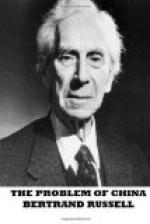[Footnote 19: Cordier, op. cit. i. p. 167.]
[Footnote 20: As far as anti-militarism is concerned, Taoism is even more emphatic. “The best soldiers,” says Lao-Tze, “do not fight.” (Giles, op. cit. p. 150.) Chinese armies contain many good soldiers.]
[Footnote 21: Giles, op. cit., Lecture VIII. When Chu Fu Tze was dead, and his son-in-law was watching beside his coffin, a singular incident occurred. Although the sage had spent his life teaching that miracles are impossible, the coffin rose and remained suspended three feet above the ground. The pious son-in-law was horrified. “O my revered father-in-law,” he prayed, “do not destroy my faith that miracles are impossible.” Whereupon the coffin slowly descended to earth again, and the son-in-law’s faith revived.]
[Footnote 22: Translated by the Bureau of Economic Information, Peking, 1920.]
[Footnote 23: Op. cit. p. 233.]
CHAPTER III
CHINA AND THE WESTERN POWERS
In order to understand the international position of China, some facts concerning its nineteenth-century history are indispensable. China was for many ages the supreme empire of the Far East, embracing a vast and fertile area, inhabited by an industrious and civilized people. Aristocracy, in our sense of the word, came to an end before the beginning of the Christian era, and government was in the hands of officials chosen for their proficiency in writing in a dead language, as in England. Intercourse with the West was spasmodic and chiefly religious. In the early centuries of the Christian era, Buddhism was imported from India, and some Chinese scholars penetrated to that country to master the theology of the new religion in its native home, but in later times the intervening barbarians made the journey practically impossible. Nestorian Christianity reached China in the seventh century, and had a good deal of influence, but died out again. (What is known on this subject is chiefly from the Nestorian monument discovered in Hsianfu in 1625.) In the seventeenth and early eighteenth centuries Roman Catholic missionaries acquired considerable favour at Court, because of their astronomical knowledge and their help in rectifying the irregularities and confusions of the Chinese calendar.[24] Their globes and astrolabes are still to be seen on the walls of Peking. But in the long run they could not resist quarrels between different orders, and were almost completely excluded from both China and Japan.
In the year 1793, a British ambassador, Lord Macartney, arrived in China, to request further trade facilities and the establishment of a permanent British diplomatic representative. The Emperor at this time was Chien Lung, the best of the Manchu dynasty, a cultivated man, a patron of the arts, and an exquisite calligraphist. (One finds specimens of his writing in all sorts of places in China.) His reply to King George III is given by Backhouse and Bland.[25] I wish I could quote it all, but some extracts must suffice. It begins:




